A Transparent Soil Experiment to Investigate the Influence of Arrangement and Connecting Beams on the Pile–Soil Interaction of Micropile Groups
Abstract
:1. Introduction
2. Physical Model Experiment
2.1. Experimental Apparatus
2.2. Transparent Soil
2.3. Micropile Group Model
2.4. Testing Procedure
3. Results and Analysis
3.1. Deformation of Piles
3.2. Soil Pressure on Piles
3.3. Displacement of the Soil
3.4. Shear Strain of the Soil
3.5. Three-Dimensional Reconstruction
4. Discussion
4.1. Comparative Analysis with Previous Research
4.2. Effect of the Arrangement
4.3. Effect of the Connecting Beams
4.4. Limitations and Further Work
5. Conclusions
Author Contributions
Funding
Institutional Review Board Statement
Informed Consent Statement
Data Availability Statement
Conflicts of Interest
References
- Zhang, Y.; Lei, Y.; Qiang, X.; Wu, D.; Wang, D.; Wang, J. Centrifugal model test of slope reinforced by multi-row micro-pile frame structure. Rock Soil Mech. 2023, 44, 1983–1994. [Google Scholar] [CrossRef]
- Aboutabikh, M.; Soliman, A.M.; El Naggar, M.H. Performance of hollow bar micropiles using green grout incorporating treated oil sand waste. J. Build. Eng. 2020, 27, 100964. [Google Scholar] [CrossRef]
- Wang, C.C.; Han, J.T.; Kim, S. A field study on the load sharing behavior of a micropiled raft underpinned by a waveform micropile. Can. Geotech. J. 2022, 59, 1175–1187. [Google Scholar] [CrossRef]
- Sun, Z.-J.; Wang, Q.; Min, R.; Duan, Q.-W. Sensitivity analysis of influencing factors of pile foundation stability based on field experiment. Structures 2023, 54, 14–22. [Google Scholar] [CrossRef]
- Gong, W.; Tang, H.; Juang, C.H.; Wang, L. Optimization design of stabilizing piles in slopes considering spatial variability. Acta Geotech. 2020, 15, 3243–3259. [Google Scholar] [CrossRef]
- Gong, W.; Tang, H.; Wang, H.; Wang, X.; Juang, C.H. Probabilistic analysis and design of stabilizing piles in slope considering stratigraphic uncertainty. Eng. Geol. 2019, 259, 105162. [Google Scholar] [CrossRef]
- Pei, Z.W.; Zhang, Y.; Nian, T.; Song, X.; Zhao, W. Performance investigation of micropile groups in stabilizing unstable talus slopes via centrifuge model tests. Can. Geotech. J. 2023, 60, 351–365. [Google Scholar] [CrossRef]
- Liu, X.L.; Yan, J.K.; Liu, L.; Han, B. Large-Scale Model Test of a Micropile Group for Landslide Control. Adv. Civ. Eng. 2021, 2021, 6687124. [Google Scholar] [CrossRef]
- Hussain, Z.; Sharma, B.; Rahman, T. Micropile group behaviour subjected to lateral loading. Innov. Infrastruct. Solut. 2019, 4, 22. [Google Scholar] [CrossRef]
- Kyung, D.; Lee, J. Interpretative Analysis of Lateral Load-Carrying Behavior and Design Model for Inclined Single and Group Micropiles. J. Geotech. Geoenviron. Eng. 2018, 144, 04017105. [Google Scholar] [CrossRef]
- Li, N.; Men, Y.M.; Yuan, L.Q.; Gao, H.; Li, J.; Wang, B.Q. Study on the Mechanical Characteristic of Micropiles Supporting Landslide under Step-Loadings. Geotech. Geol. Eng. 2020, 38, 2761–2771. [Google Scholar] [CrossRef]
- Dong, J.; Wu, Z.H.; Li, X.; Chen, H.Y. Dynamic response and pile-soil interaction of a heavy-haul railway embankment slope reinforced by micro-piles. Comput. Geotech. 2018, 100, 144–157. [Google Scholar] [CrossRef]
- Li, N.; Men, Y.M.; Yuan, L.Q.; Wang, B.Q.; Li, J.; Liu, X.L. Seismic response of micropiles-reinforced landslide based on shaking table test. Geomat. Nat. Hazards Risk 2019, 10, 2030–2050. [Google Scholar] [CrossRef]
- Yuan, B.X.; Sun, M.; Xiong, L.; Luo, Q.Z.; Pradhan, S.P.; Li, H.Z. Investigation of 3D deformation of transparent soil around a laterally loaded pile based on a hydraulic gradient model test. J. Build. Eng. 2020, 28, 101024. [Google Scholar] [CrossRef]
- Liu, C.; Tang, X.W.; Wei, H.W.; Wang, P.P.; Zhao, H.H. Model Tests of Jacked-Pile Penetration into Sand Using Transparent Soil and Incremental Particle Image Velocimetry. Ksce J. Civ. Eng. 2020, 24, 1128–1145. [Google Scholar] [CrossRef]
- Wang, Z.T.; Luo, G.Y.; Kong, G.Q.; Zhang, Y.; Lu, J.Q.; Chen, Y.; Yang, Q. Centrifuge model tests on anchor pile of single point mooring system under oblique pullout load using transparent sand. Ocean. Eng. 2022, 264, 112441. [Google Scholar] [CrossRef]
- Wang, J.X.; Liu, X.T.; Liu, S.L.; Zhu, Y.F.; Pan, W.Q.; Zhou, J. Physical model test of transparent soil on coupling effect of cut-off wall and pumping wells during foundation pit dewatering. Acta Geotech. 2019, 14, 141–162. [Google Scholar] [CrossRef]
- Li, Y.Z.; Zhou, H.; Liu, H.L.; Ding, X.M.; Zhang, W.G. Geotechnical properties of 3D-printed transparent granular soil. Acta Geotech. 2021, 16, 1789–1800. [Google Scholar] [CrossRef]
- Chen, Q.; Dong, G.; Wang, C.; Zhu, B.; Zhao, X. Characteristics Analysis of Soil Arching Effect Behind Pile Based on Transparent Soil Technology. J. Southwest Jiaotong Univ. 2020, 55, 509–522. [Google Scholar]
- Sui, W.H.; Zheng, G.S. An experimental investigation on slope stability under drawdown conditions using transparent soils. Bull. Eng. Geol. Environ. 2018, 77, 977–985. [Google Scholar] [CrossRef]
- Wei, L.T.; Qiang, X.; Wang, S.Y.; Wang, C.L.; Xu, J. The morphology evolution of the shear band in slope: Insights from physical modelling using transparent soil. Bull. Eng. Geol. Environ. 2020, 79, 1849–1860. [Google Scholar] [CrossRef]
- Yang, C.; Tong, X.; Wu, D.; Lian, J.; Ding, X. A new model for mechanical calculation of h-type anti-slide piles. Structures 2023, 56, 104891. [Google Scholar] [CrossRef]
- Hu, X.L.; Liu, D.Z.; Niu, L.F.; Liu, C.; Wang, X.; Fu, R. Development of soil-pile interactions and failure mechanisms in a pile-reinforced landslide. Eng. Geol. 2021, 294, 106389. [Google Scholar] [CrossRef]
- He, C.; Hu, X.L.; Liu, D.Z.; Xu, C.; Wu, S.S.; Wang, X.; Zhang, H. Model tests of the evolutionary process and failure mechanism of a pile-reinforced landslide under two different reservoir conditions. Eng. Geol. 2020, 277, 105811. [Google Scholar] [CrossRef]
- Jia, J.; Wang, Z. Kinematic limit analysis method for micro-pile reinforced 3D trapezoidal slope. Arab. J. Geosci. 2022, 15, 1146. [Google Scholar] [CrossRef]
- Pei, Z.; Zhang, Y.; Nian, T.; Xiao, S.; Liu, H. Cross-Scale Analysis on the Working Performance of Micropile Group and Talus Slope System. Sustainability 2023, 15, 8154. [Google Scholar] [CrossRef]
- Li, C.D.; Wu, J.J.; Tang, H.M.; Wang, J.; Chen, F.; Liang, D.M. A novel optimal plane arrangement of stabilizing piles based on soil arching effect and stability limit for 3D colluvial landslides. Eng. Geol. 2015, 195, 236–247. [Google Scholar] [CrossRef]
- Federal Highway Administration. Micropile Design and Construction Guidelines Implementation Manual; United States Department of Transportation: Dallas, TX, USA, 2000. [Google Scholar]
- Federal Highway Administration. Micropile Design and Construction; United States Department of Transportation: Dallas, TX, USA, 2005. [Google Scholar]
- Liu, C.; Tang, X.W.; Wei, H.W.; Zhao, H.H. A New Spatial Deformation Measurement Method Using 3D Reconstruction Technology during Pile Penetration. Ksce J. Civ. Eng. 2021, 25, 4106–4120. [Google Scholar] [CrossRef]
- Liu, K.; Xu, C.; Jia, K.; Zhang, X. Measurement of earth pressures on curved surface of thin film pressure sensor. Chin. J. Geotech. Eng. 2020, 42, 584–591. [Google Scholar]
- Dontha, B.; Swearingen, K.; Swearingen, S.; Thrane, S.E.; Kiourti, A. Wearable Sensors Based on Force-Sensitive Resistors for Touch-Based Collaborative Digital Gaming. Sensors 2022, 22, 342. [Google Scholar] [CrossRef]
- Liu, X.L.; Liu, Y.S.; Liu, K.; Su, Y.Y. Experimental investigation on anti-sliding performance of grouted micro-pipe pile groups. Nat. Hazards 2022, 113, 1367–1384. [Google Scholar] [CrossRef]
- Moayed, R.Z.; Naeini, S.A. Imrovement of loose sandy soil deposits using micropiles. KSCE J. Civ. Eng. 2012, 16, 334–340. [Google Scholar] [CrossRef]
- Sun, S.; Zhu, B.; Ma, H. Model experimental research on anti-sliding characteristics of micropiles with cap beam. Chin. J. Rock Mech. Eng. 2010, 29, 30. [Google Scholar]
- Lai, H.J.; Zheng, J.J.; Cui, M.J.; Chu, J. “Soil arching” for piled embankments: Insights from stress redistribution behaviour of DEM modelling. Acta Geotech. 2020, 15, 2117–2136. [Google Scholar] [CrossRef]
- Fang, K.; Miao, M.H.; Tang, H.M.; Dong, A.; Jia, S.X.; An, P.J.; Zhang, B.C.; Tu, J.M. Model test on deformation and failure behaviour of arching-type slope under excavation condition. Eng. Geol. 2022, 302, 106628. [Google Scholar] [CrossRef]
- Xin, J.; Zheng, Y.; Tang, X. Research on failure mechanism of anti-sliding micropiles Based on elastoplastic model. Chin. J. Rock Mech. Eng. 2014, 33, 4113–4121. [Google Scholar]
- Zeng, J.X.; Xiao, S.G. A Simplified Analytical Method for Stabilizing Micropile Groups in Slope Engineering. Int. J. Civ. Eng. 2020, 18, 199–214. [Google Scholar] [CrossRef]
- Hirai, H. Analysis of piles subjected to lateral soil movements using a three-dimensional displacement approach. Int. J. Numer. Anal. Methods Geomech. 2016, 40, 235–268. [Google Scholar] [CrossRef]
- Ashour, M.; Pilling, P.; Norris, G. Lateral behavior of pile groups in layered soils. J. Geotech. Geoenvironmental Eng. 2004, 130, 580–592. [Google Scholar] [CrossRef]
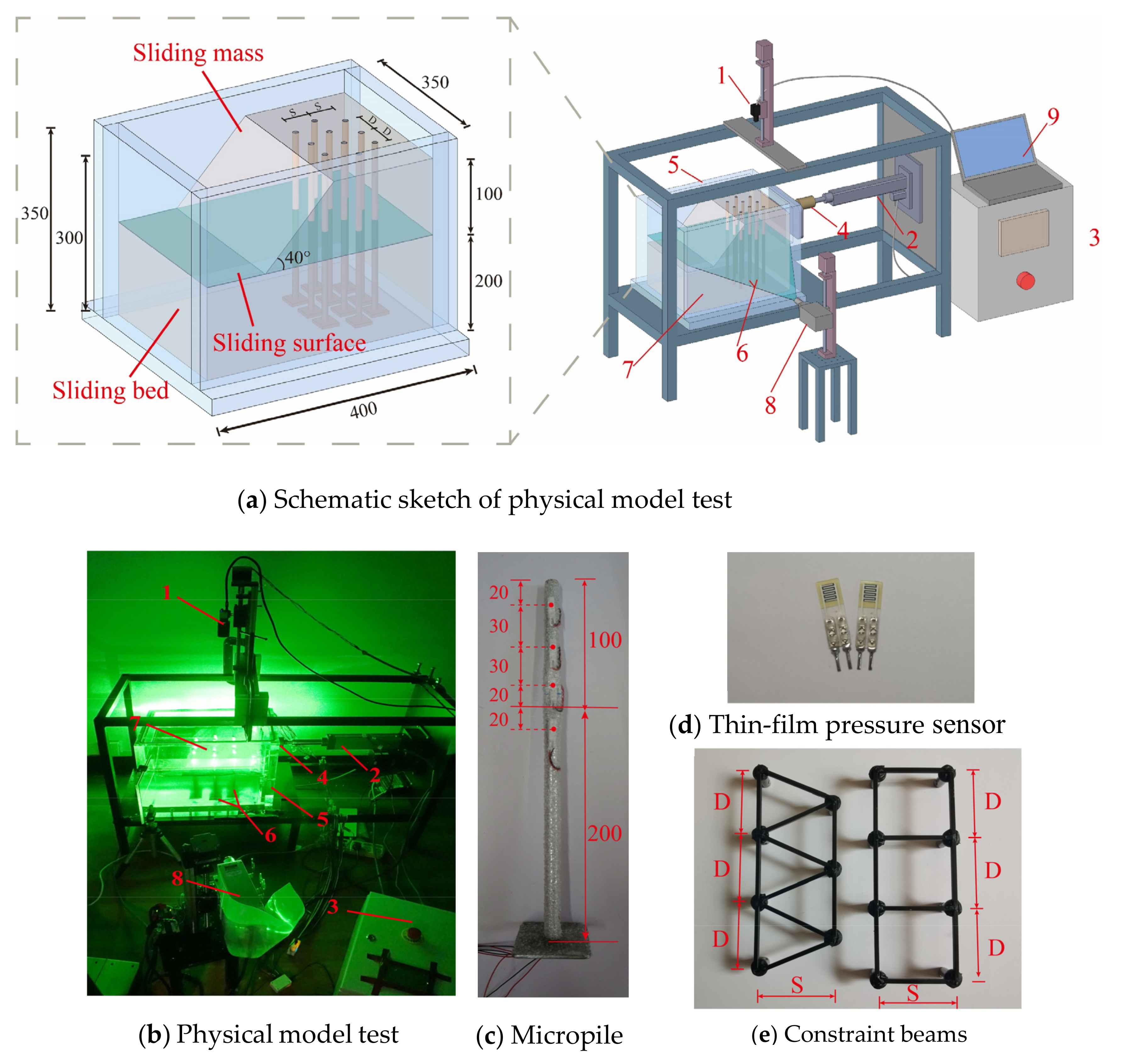


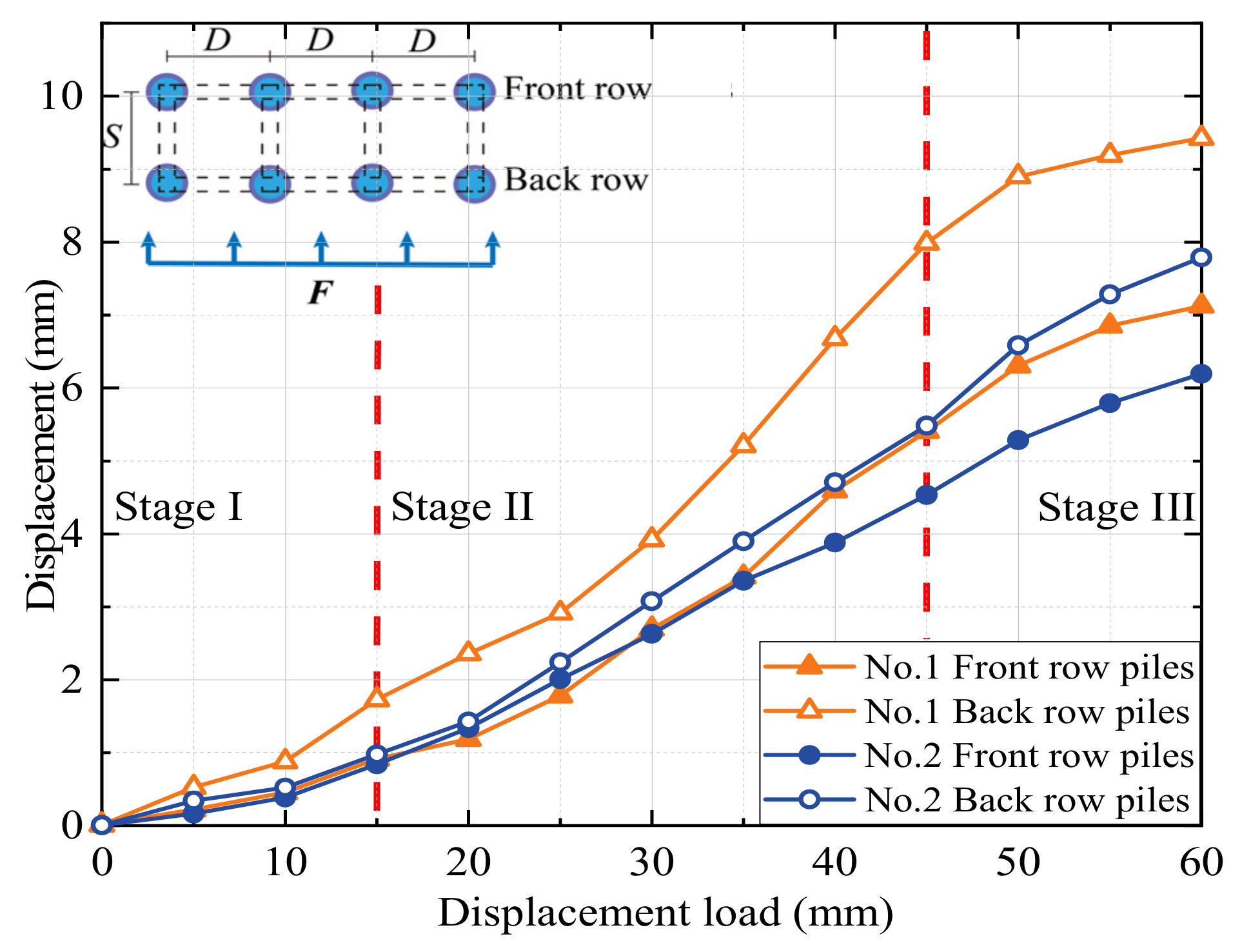
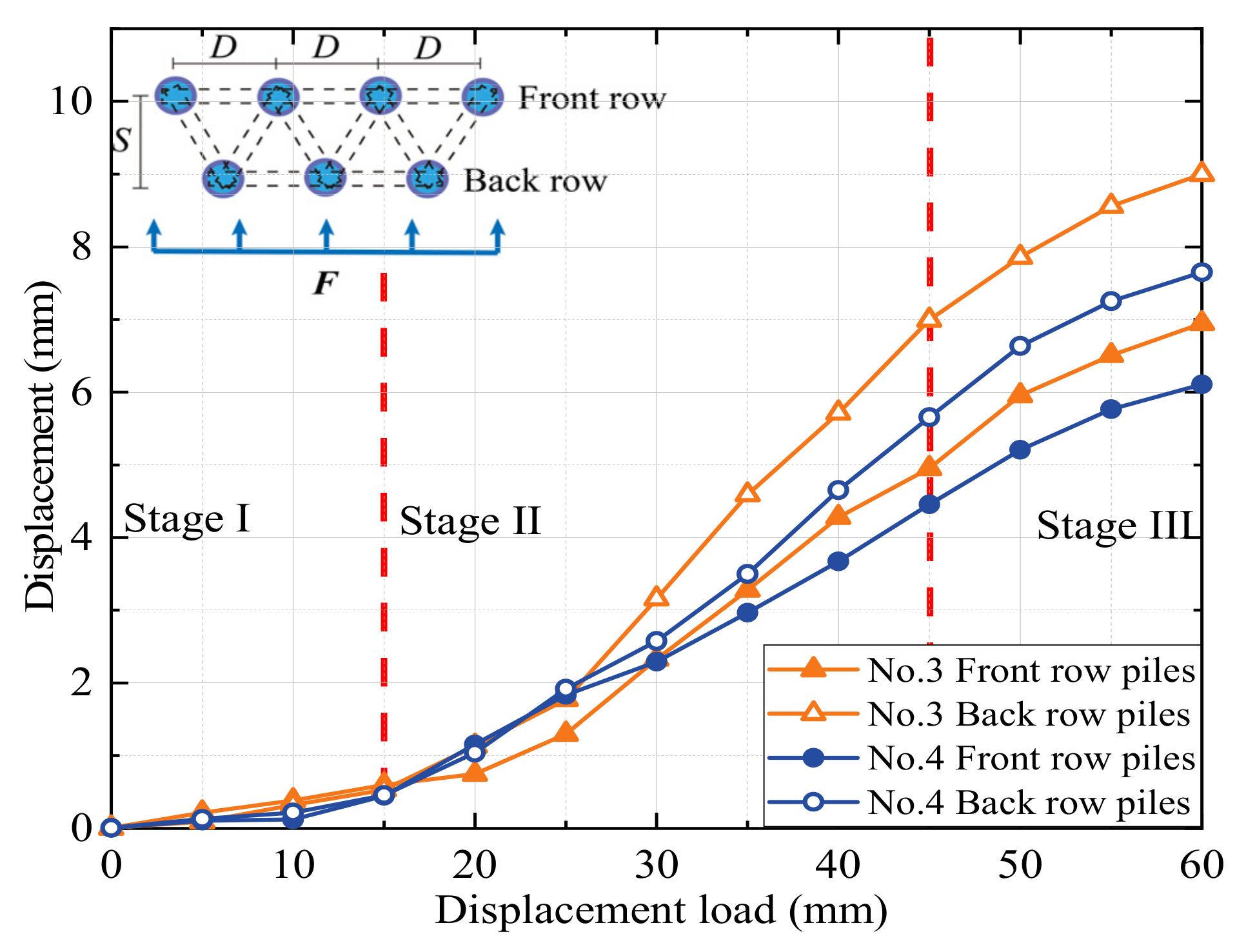
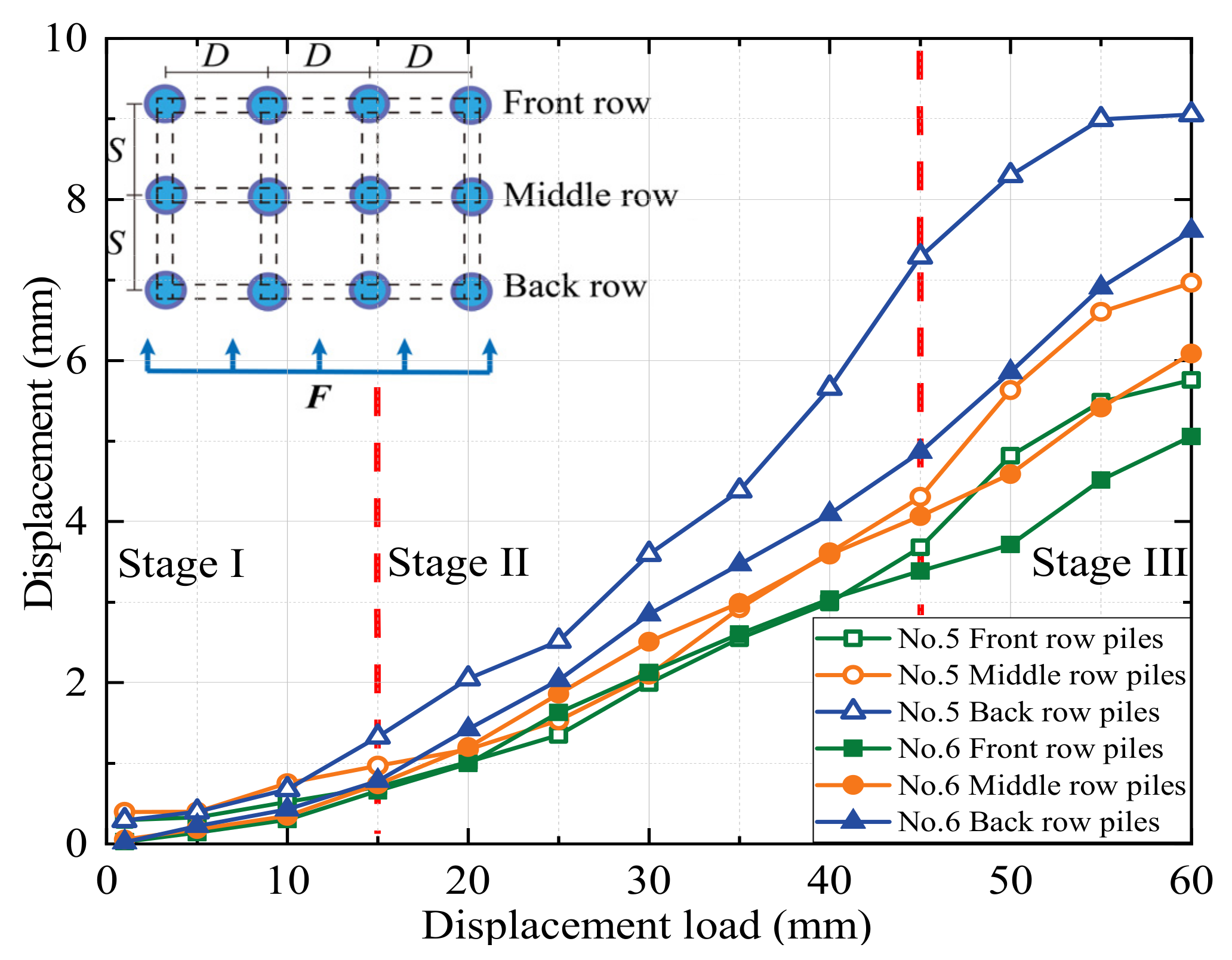
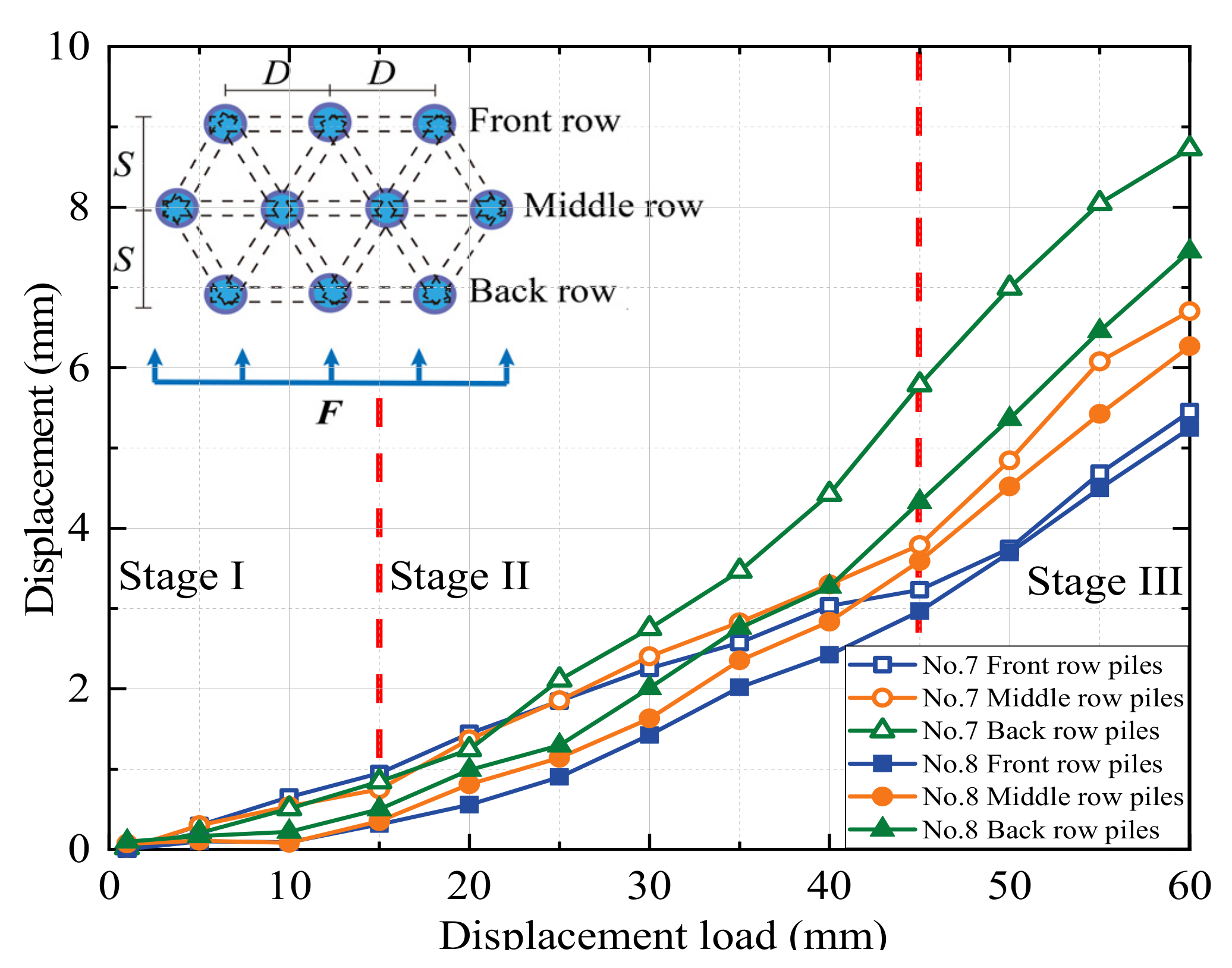

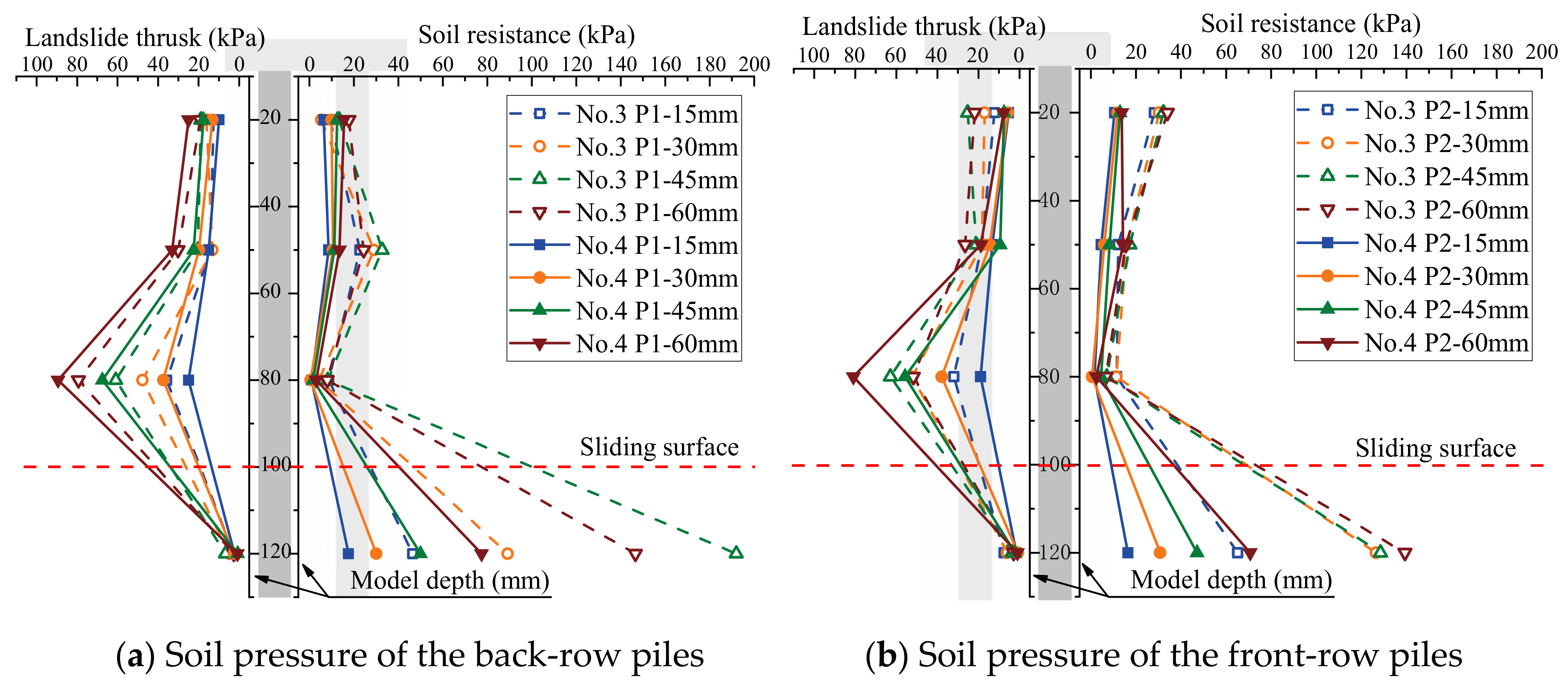




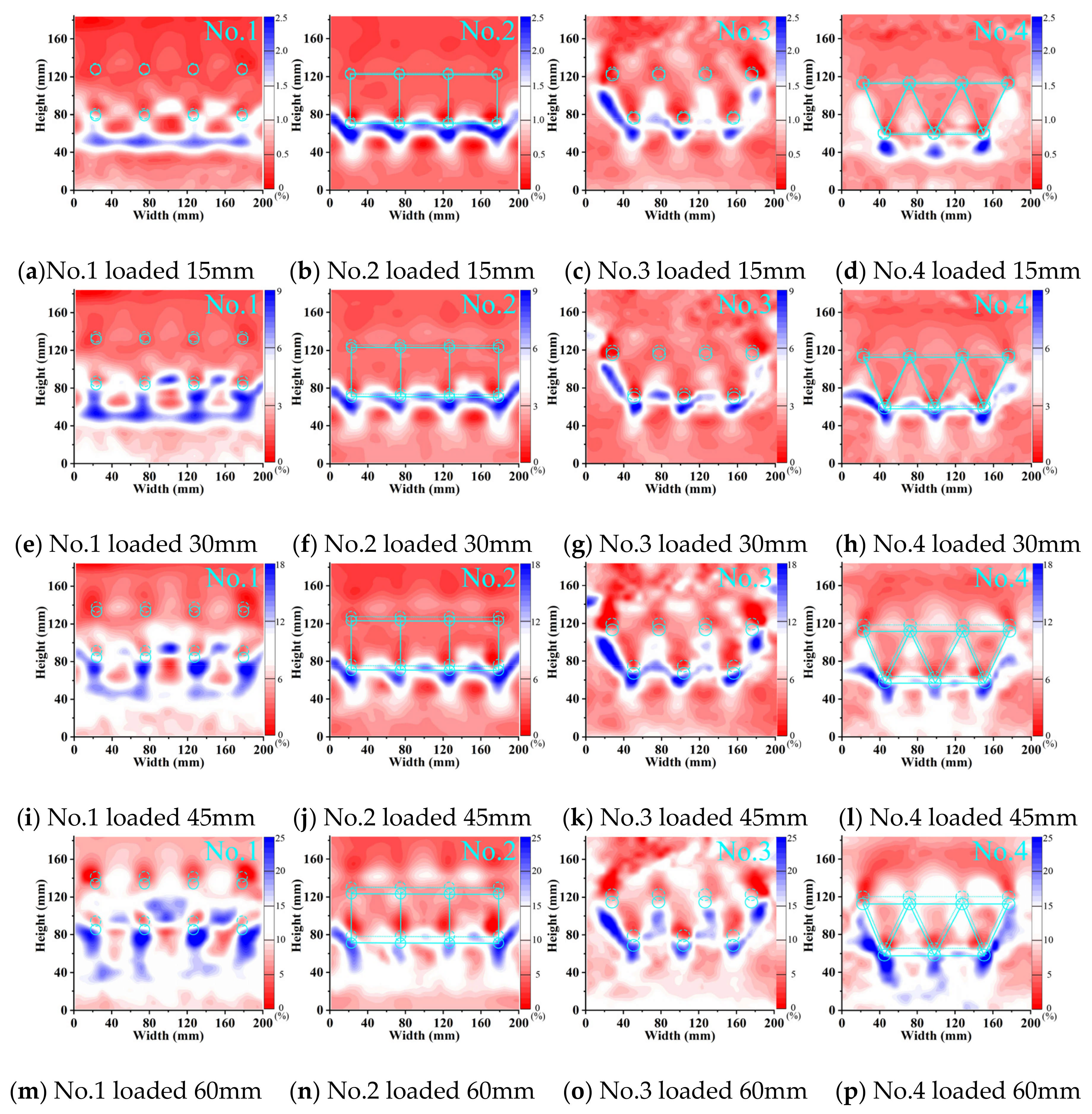
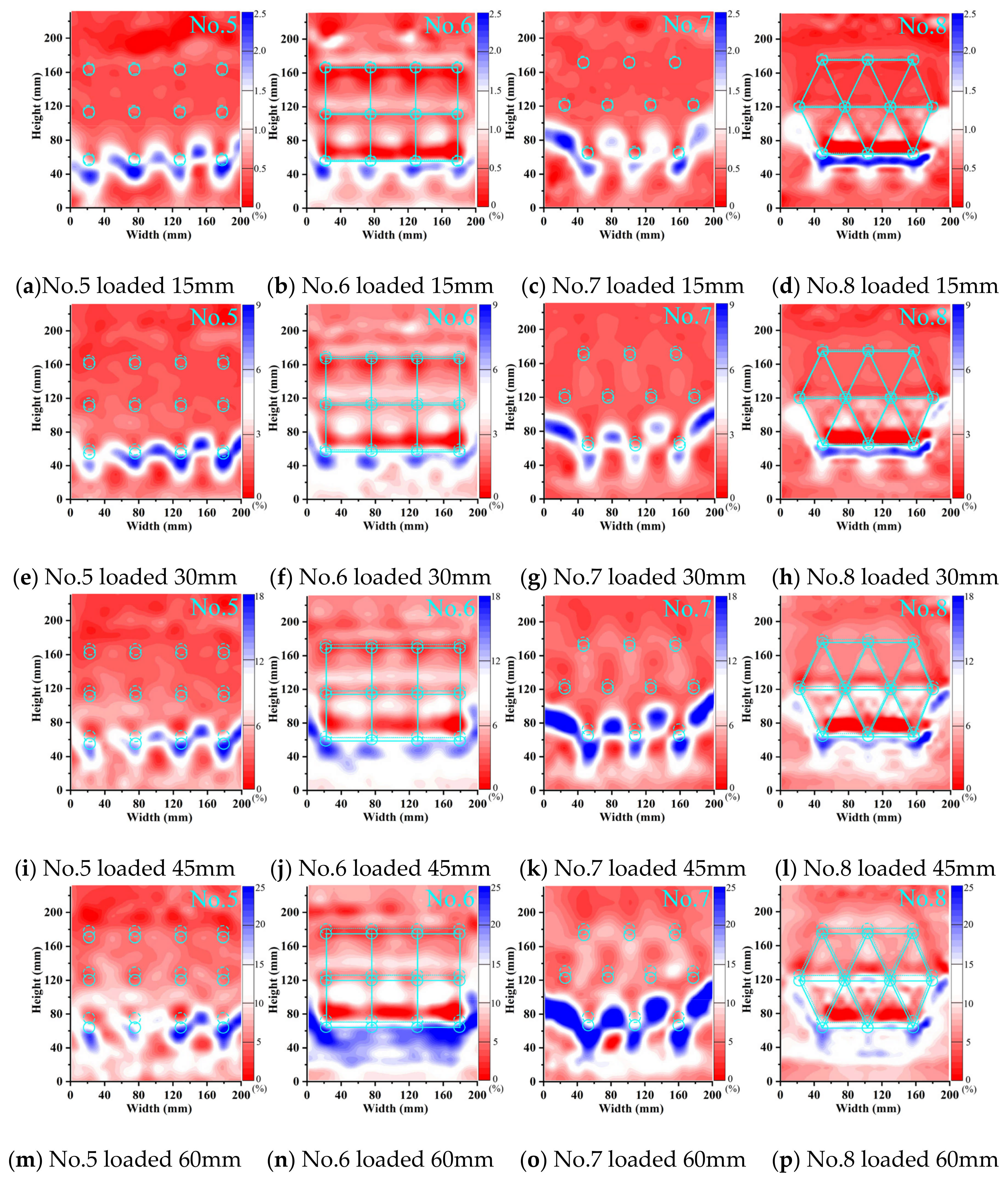

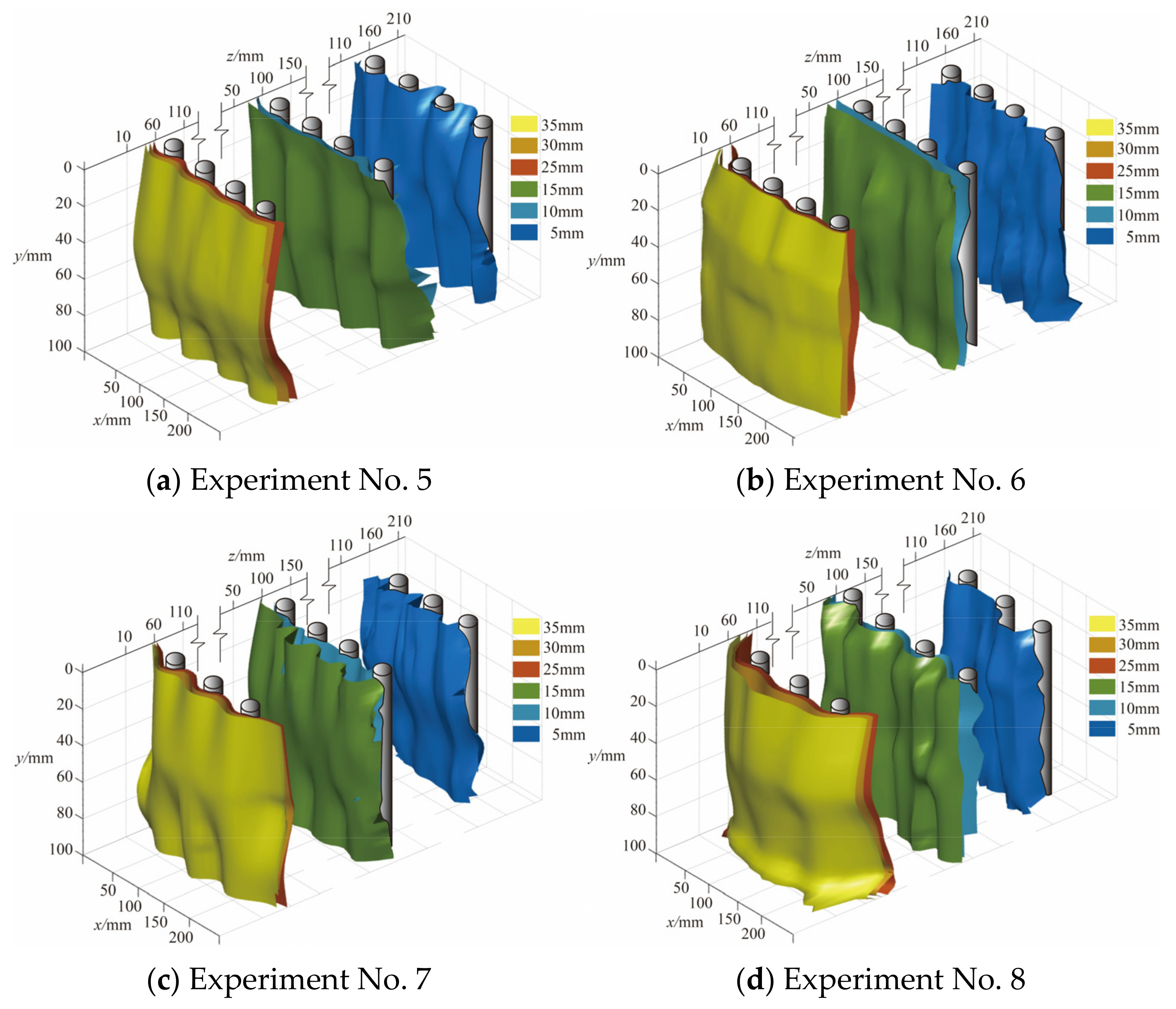
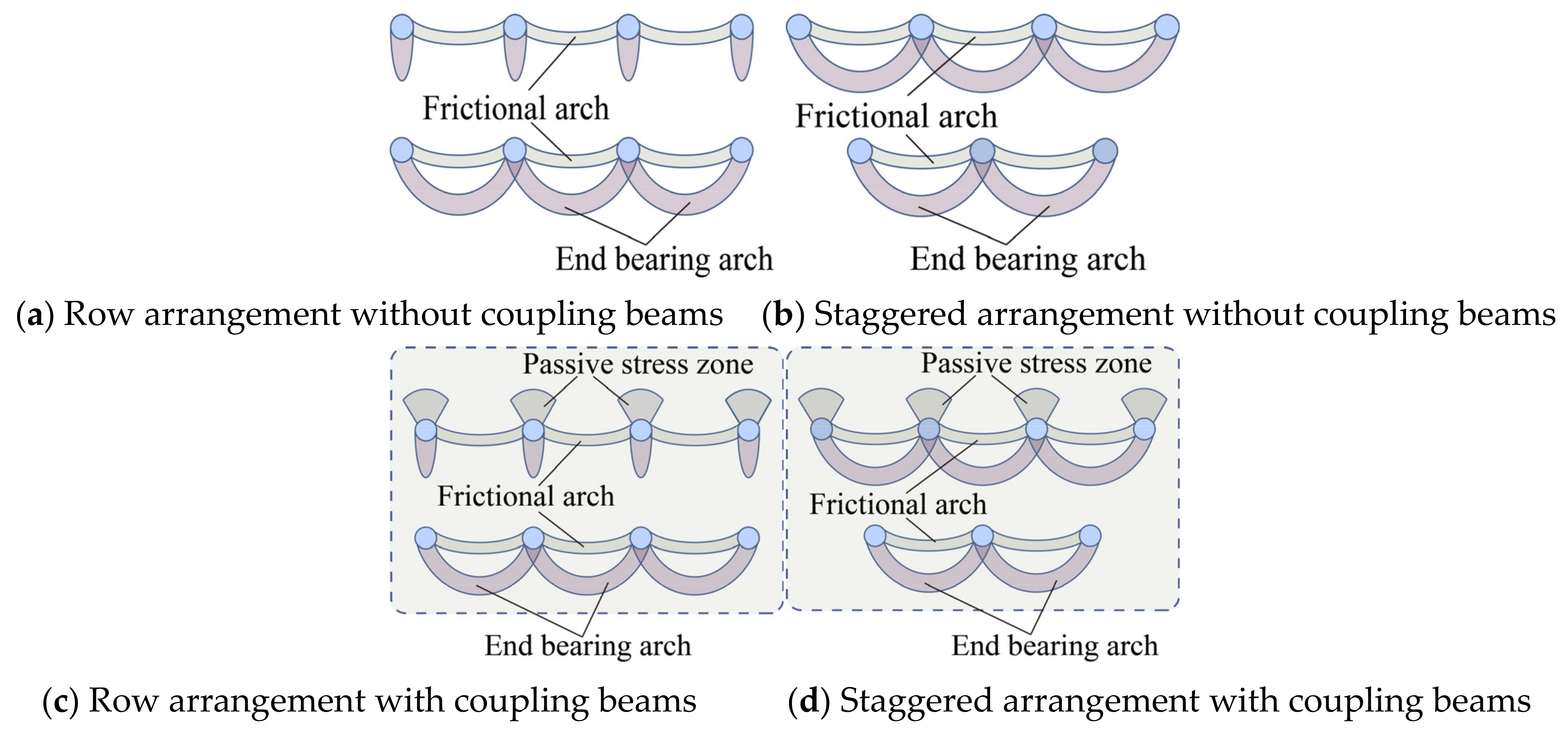
| Table | Experiments | Arrangement Form | Coupling Beam | Sketch |
|---|---|---|---|---|
| Group 1 Double rows | No.1 | Row | Without coupling beam |  |
| No.2 | Row | With coupling beam |  | |
| No.3 | Staggered | Without coupling beam |  | |
| No.4 | Staggered | With coupling beam |  | |
| Group 2 Three rows | No.5 | Row | Without coupling beam |  |
| No.6 | Row | With coupling beam |  | |
| No.7 | Staggered | Without coupling beam |  | |
| No.8 | Staggered | With coupling beam |  |
Disclaimer/Publisher’s Note: The statements, opinions and data contained in all publications are solely those of the individual author(s) and contributor(s) and not of MDPI and/or the editor(s). MDPI and/or the editor(s) disclaim responsibility for any injury to people or property resulting from any ideas, methods, instructions or products referred to in the content. |
© 2024 by the authors. Licensee MDPI, Basel, Switzerland. This article is an open access article distributed under the terms and conditions of the Creative Commons Attribution (CC BY) license (https://creativecommons.org/licenses/by/4.0/).
Share and Cite
Wang, Z.; Jia, J.; Zhang, L. A Transparent Soil Experiment to Investigate the Influence of Arrangement and Connecting Beams on the Pile–Soil Interaction of Micropile Groups. Sensors 2024, 24, 5448. https://doi.org/10.3390/s24165448
Wang Z, Jia J, Zhang L. A Transparent Soil Experiment to Investigate the Influence of Arrangement and Connecting Beams on the Pile–Soil Interaction of Micropile Groups. Sensors. 2024; 24(16):5448. https://doi.org/10.3390/s24165448
Chicago/Turabian StyleWang, Ziyi, Jinqing Jia, and Lihua Zhang. 2024. "A Transparent Soil Experiment to Investigate the Influence of Arrangement and Connecting Beams on the Pile–Soil Interaction of Micropile Groups" Sensors 24, no. 16: 5448. https://doi.org/10.3390/s24165448





